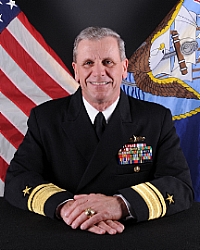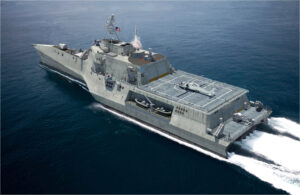
The two Littoral Combat Ship variants, LCS-1 Freedom (far) and LCS-2 Independence (near).
WASHINGTON: After years of delays, budget fights, and searing debates over the role that the ship will play, three Littoral Combat Ships will head out on their first deployments this year.

Rear Adm. Richard Brown
“We’re deploying LCS this year. It’s happening. Two ships are going on the West Coast, one ship is going on the East Coast,” said Vice Admiral Richard Brown, head of the Navy’s surface fleet.
“There will always be LCS forward deployed now, just like we designed the program,” Brown told reporters. “We are very excited about that because the naval component commanders are screaming for LCS because they know what they’re going to bring to the fight.”
During 2019, two Independence-class (trimaran) ships, the USS Montgomery and USS Gabrielle Giffords will deploy from San Diego to the Pacific, while the Freedom-class (single-hull) USS Detroit will deploy to the East Coast. In 2020, Detroit will be followed by USS Little Rock, which became infamous last year for being stuck in the ice near Montreal from December through March, and unable to move.
The Navy failed to deploy any LCS vessels in 2018 after overhauling the training for crews as the program continued to run into trouble.
It won’t be the first deployment for LCS. The USS Freedom, USS Fort Worth, and USS Coronado had previously deployed to Singapore, where the small crews reportedly struggled to keep up with maintenance demands. The Navy later redesignated these early LCS ships as research and development vessels that would no longer deploy save in emergency situations.
Since then, the service has completely rethought how it trains and deploys crews for the LCS, leading to questions over how the new deployments will be run, and how the crews are prepared to go to sea.
The deploying ships will be outfitted with the Surface Warfare mission module, Brown said, “then we’re building the ASW [anti-submarine warfare] modules and then finishing up the Mine Counter-Measure modules [MCM].” Delays to the minesweeping systems have attracted some sharp criticism from Congress and analysts.
The ships were designed to perform single mission, and they’ll stick to that plan, Brown said. While he declined to offer specifics, it will likely involve crew training, partner operations, and fisheries enforcement, he said, though “that’s really up to the 7th Fleet commander.”
The new LCS deployments come as the Navy is preparing to move past the program.

Austal’s proposal for an LCS frigate with Vertical Launch System (VLS) tubes.
The Navy plans to make an award in its next-generation frigate program in 2019, which will take over some of the previously envisioned LCS missions. The Navy sees the program as a relatively quick way to make up for the shortfalls in the LCS program, either by upgrading the current designs or using modified versions of larger, more combat-capable warships already in services with allied nations.
Austal USA has offered an upgraded Independence-class LCS; General Dynamics’ Bath Iron Works, the Spanish Navantia Álvaro de Bazán-class F100 frigate; Lockheed Martin and Fincantieri Marinette Marine, an upgraded, Freedom-class LCS; and Huntington Ingalls Industries has only released artists’ renderings of what it might compete with, such as a modified Coast Guard National Security Cutter. Each company was awarded $15 million contracts to provide the Navy with designs. The Navy plans to buy 20 frigates, at an average cost of $800 million each, starting in 2020.
The LCS might live on in other forms, however.
In 2015, the Obama administration kicked off the $11.2 billion Multi-Mission Surface Combatant program with Saudi Arabia, which consists of four ships modeled on the Freedom variant of LCS.
Since March of last year, Lockheed Martin has been awarded over $930 million in contracts to begin planning for construction of the four ships, which feature the Mk41 missile launching system derived from the Aegis system used by US and allied navies. They boasts a range of 5,000 nautical miles.
And Congress has always had a soft spot for the ship, which is built at relatively small shipyards — Austal in Louisiana and Marinette in Wisconsin — that normally don’t get Navy contracts.
For the 2019 fiscal year, Congress added money for the 33rd, 34th and 35th LCS hulls, three more than the 32-ship Navy requirement. At the same time, however, appropriators removed funding for the ASW package that the Navy was planning to declare operational this year. Overall, the NDAA greenlit just over $7 million, well below the $57 million requested by the Navy.
The Freedom-class ships are built by a consortium of Lockheed Martin, Fincantieri and its subsidiary Marinette Marine, while the Independence-class are made by General Dynamics and Austal.
Major trends and takeaways from the Defense Department’s Unfunded Priority Lists
Mark Cancian and Chris Park of CSIS break down what is in this year’s unfunded priority lists and what they say about the state of the US military.


























